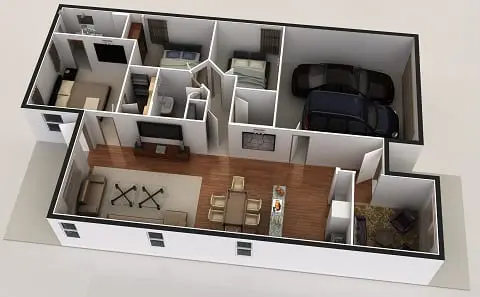
As a Realtor, you’ve probably looked at so many homes and so many floor plans that you can quickly conjure up an image of what rooms will look like before they exist.
For buyers, though, buying a newly built home from a set of floor plans or choosing options from two-inch samples can feel like grasping for a glass of water in the dark. Thankfully, many builders now offer three-dimensional imagery as a marketing tool for their homes and optional features.
“The vast majority of people, something like 70 percent I read in one survey, can’t look at a two-dimensional floor plan and understand what the home will look like,” says Charlie Engel, key account manager in North America for DIAKRIT International, a provider of 3-D imagery for multifamily communities in the United States. “3-D imagery helps people understand the flow of spaces and visualize what something will look like with furniture in it. Its best use is for when no model home exists.”
Andrew Peacock, senior manager of BHI Media, says that homebuilders must compete against used homes, which typically have 25 or more photos online so people know what the home looks like even before they visit.
“Instead of looking at a floor plan or a sketch of the exterior of a building, 3-D imagery gives people a much better idea of what a home will look like,” says Peacock. “A big part of looking at homes is the emotion they evoke and sketches and drawings just don’t bring out emotion the way a 3-D image does.”
How 3-D Imagery Works
Specialized 3-D imagery software can take a home from the proverbial hand-drawn sketch on a napkin to a crisp two-dimensional floor plan and to a fully interactive 3-D image that shows the flooring, appliances, granite counters and other features, says Engel.
“The next step is a 3-D panorama, which is almost like augmented reality,” he says.
Van Metre Homes, based in Stone Ridge, Va., uses 3-D imagery to presale condos in an elevator building so that prospective buyers can look into each floor and see each unit.
“We also had a hologram created that we use in the sales office for townhouses and condos that can be hard to visualize,” says Merle Phillips, vice president of sales and marketing for Van Metre Homes. “You can walk around a turntable and as you walk around it you see different images of the exterior, the garage with cars in it and different units with different finishes.”

Phillips says the hologram in the sales office and 3-D renderings on the website were especially helpful to sell townhouses with an unusual architectural style with a mix of attached and detached rear garages and pathways that were difficult to explain with a two-dimensional printed brochure.
“We’re finding that virtual reality displays are much more effective than scale models, so we’re replacing those models of communities with the little plastic trees and cars with 3-D imagery,” says T.J. Marable, a marketing coordinator for Van Metre Homes.
Peacock says that, in recent years, technological improvements to 3-D imagery have developed into a “photo real” style with grass and landscaping that looks more realistic than earlier versions of 3-D marketing.
Interactive 3-D Imagery For Buyers
“3-D imagery is great for selecting floor plan options and finishes,” says Peacock. “Buyers can bring up an interior rendering or animation and then click on a ‘hot spot’ to zoom in on a particular room and customize their home.”
Peacock says buyers can find these interactive images on builder’s individual websites (and on NewHomeSourceProfessional.com) so they can search for a community, find a home, click on the hot spots and save or print their choices to bring to their chosen builder.
“A prospective buyer can see immediately what they can build and then go to the builder’s sales office to discuss their options in detail,” says Peacock. “It’s a great starting point for buying a home.”
Buyers can use 3-D imagery online, at an interactive kiosk in a sales office or in the design studio to select features and finishes for their homes, says Marable.
“It makes the sales process so much easier if people can dream online and see what their kitchen will look like with a variety of cabinets in different colors and various countertops,” says Marable. “They can use 3-D imagery for the exterior, too, to decide if they want stone or brick, to choose the color of their siding and to select trim details.”
Marable says many buyers find the design studio overwhelming and prefer to experiment at home to narrow their choices. “They’re not restricted by the design center hours, either, so they can do it at midnight if they want,” says Marable.
Engel says 3-D imagery even allows buyers to test out their furniture in different rooms to make sure their sectional sofa will fit in their new living room or that the bedroom can easily accommodate a king-sized bed.
“The 3-D imagery can be especially helpful when people are downsizing into a condo or townhouse so they can scale their furniture to their rooms,” says Marable.
Benefits of 3-D Imagery
“3-D imagery keeps consumers more engaged when they encounter it on a website,” says Engel. “People who interact with a 3-D model online are stronger leads when they meet with a Realtor or a builder because they already have an idea of what they’re looking for.”
Engel says Realtors can show buyers 3-D imagery to help them understand the flow of space in a home, how it will look with different options and how their furniture will fit into the rooms.
“The Realtor and buyers can then print out what they think they want and come into the sales office to look at physical samples and floor plans and learn about the availability and cost of what they want,” says Engel. “It’s really just one more tool Realtors can use to educate buyers.”
Editor’s Note: BHI Media is a subsidiary of Builder Homesite Inc., the parent company of New Home Source Professional.

